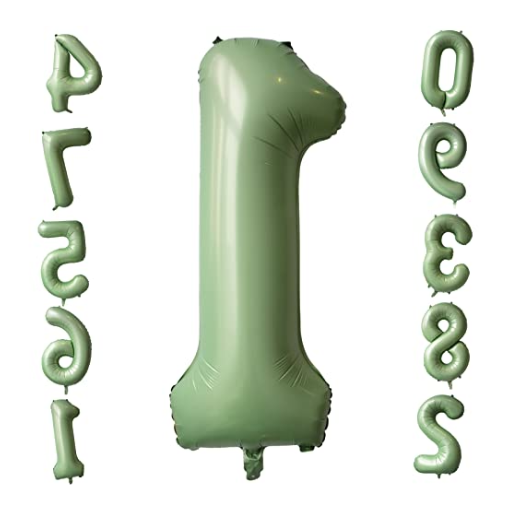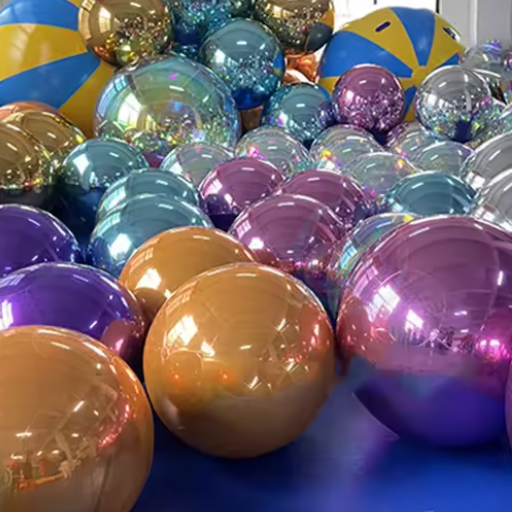Foil helium balloons are in great demand for celebrations, parties, and special occasions, providing a bright, catch-your-eye way to beautify any event. But have you ever wondered how long these balloons would last? Knowing the lifespan will help you coordinate your event better and avoid last-minute panic, thus better utilizing your decor. This write-up talks about the longevity of foil helium balloons, factors that influence their life, and a few tips on how to keep them up for as long as possible. Whatever you are planning, be it a birthday, reception, or any festive occasion, this must-read is just about to save you.
Introduction to Foil Helium Balloons

Foil helium balloons are the most favored option for parties because of their flamboyant designs and longer helium holding capacity compared to latex balloons. As these balloons are thin and metallic, an exterior layer is applied to render the material a little less porous so that helium can stay sealed for a longer duration. This durability factor makes them most suitable for parties that require longer-lasting decorations. Also, they come in varied shapes, sizes, and patterns, which can be easily customized to suit any occasion.
What are Foil Balloons?
Foil balloons are durable, helium-retaining decorative balloons made from a thin and flexible metal-coated material. They are usually sought after for their longer float time and unlimited designs!
Differences Between Foil and Latex Balloons
|
Parameter |
Foil Balloons |
Latex Balloons |
|---|---|---|
|
Material |
Metalized plastic (Mylar) |
Natural rubber (biodegradable) |
|
Durability |
Highly durable, resists punctures |
Less durable, prone to popping |
|
Float Time |
Up to 2 weeks |
12-24 hours (helium-filled) |
|
Customization |
Intricate shapes, detailed designs |
Wide color range, simple prints |
|
Cost |
More expensive |
Budget-friendly |
|
Environmental Impact |
Non-biodegradable |
Biodegradable |
|
Best Use |
Long-lasting events, formal occasions |
Short-term events, casual gatherings |
|
Shapes Available |
Stars, hearts, letters, numbers |
Round, heart, basic shapes |
|
Inflation Options |
Helium or air, self-sealing |
Helium, air, or water |
|
Visual Appeal |
Metallic sheen, vibrant colors |
Matte or glossy, versatile colors |
Popular Uses for Helium Balloons
The greater versatility of helium balloons makes this valuable element for all kinds of parties and occasions. Their ability to float elegantly and great-looking designs imply that they are the go-to elements for decoration and celebration. Included below are the five significant areas of helium balloon application:
Birthday Parties
These balloons of helium are the classical decoration for birthdays. They can be fashioned into pretty bouquets; they can build fancy arches or, just allowing to float somewhere, they could be centerpieces that assert an upbeat atmosphere.
Weddings
Helium balloons lend sophistication mixed with whimsy for weddings. From romantic hearts to classy color schemes, they may be used for table decorations, outdoors, or as a backdrop for photographs.
Corporate Events
Businesses use helium balloons as attention-getting devices at grand openings, product launches, and trade shows. Custom-branded balloons with logos or promotional designs are quite popular for brand visibility.
Anniversaries and Milestones
Helium balloons give anniversary or milestone parties a bright and festive feel. They are often customized to feature dates, messages, or numbers denoting the years being celebrated.
Parades and Festivals
Helium balloons, from giant character-themed ones to colorful clusters used for decorating, take pride of place at parades and festivals. Their size and floating aptitude make them the perfect tool for lifting the spirit of these events.
Average Float Time of Helium Balloons

The average float time of helium balloons varies with size and material. Regular helium-filled latex balloons usually float for approximately 8 to 12 hours, and foil (or Mylar) balloons can last anywhere between 2 and 5 days. One last thing: adding a sealant to latex balloons increases their float time to 24 hours. Some environmental forces, such as temperature and pressure, may also affect longevity.
How Long Do Helium Balloons Last?
Helium balloon days range between 8 hours and 5 days, depending on material, size, and environmental conditions. A latex balloon can float for about 8-12 hours, while a foil balloon may stay afloat for 2-5 days.
Factors Affecting Float Time
Numerous factors influence the float time of helium balloons, and knowing about them can maximize the life span:
- Material of the Balloon
It plays a major role in determining the float time of a helium balloon. Latex is a porous material that allows the helium to escape over time, so the float time is just about 8-12 hours. Mylar (or foil) balloons, however, have a non-porous surface, keeping the helium much longer and thus having a float time of 2-5 days. If recent studies are to be believed, latex balloons specially treated with sealants can often stay afloat for up to 24 hours.
- Size of the Balloon
Bigger balloons contain more helium and thus can float longer. An average 9-inch latex balloon generally floats for 8 hours. A big 36-inch helium-filled balloon may float for a couple of days, given that the extra volume reduces helium’s escape rate.
- Temperature and Other Environmental Conditions
Some of the most extraordinary diminution to float time is given by temperature fluctuations. Helium wants to expand in heat and contract in cold weather, thus ruining the balloons’ buoyant force prematurely. For instance, if a bunch of outdoor balloons gets good sunlight, they might heat up and consequently lose helium faster or even pop. Indoors and stable temperatures of around 68°F (20°C) are the best for float time. Though high humidity is good for latex balloons initially, it deteriorates the latex over time, thereby deflating the balloons.
- Seal and Tying Technique
Improperly done sealing creates a fast escape route for helium, thus shortening float time. Using high-quality closures or adding balloon sealant may increase the time a balloon can stay afloat by creating or enhancing the airtight seal. Studies have shown that sealants can almost double the float time of a regular latex balloon.
- Helium Purity
The purity of the helium filling the balloons counts. Better-grade helium will float much longer than helium diluted with air. For events where maximum float time is critical, 100% helium is assuredly a better choice.
Thus, by paying heed to these factors and planning accordingly, helium balloons will float for a long time, leaving an everlasting impression for any occasion.
Comparison: Foil Balloons vs. Latex Balloons
|
Parameter |
Foil Balloons |
Latex Balloons |
|---|---|---|
|
Material |
Metalized plastic (Mylar) |
Natural rubber (biodegradable) |
|
Durability |
Highly durable, resists punctures |
Less durable, prone to popping |
|
Float Time |
Up to 2 weeks |
12-24 hours (helium-filled) |
|
Customization |
Intricate shapes, detailed designs |
Wide color range, simple prints |
|
Cost |
More expensive |
Budget-friendly |
|
Environmental Impact |
Non-biodegradable |
Biodegradable |
|
Best Use |
Long-lasting events, formal occasions |
Short-term events, casual gatherings |
|
Shapes Available |
Stars, hearts, letters, numbers |
Round, heart, basic shapes |
|
Inflation Options |
Helium or air, self-sealing |
Helium, air, or water |
|
Visual Appeal |
Metallic sheen, vibrant colors |
Matte or glossy, versatile colors |
|
Reusability |
Reusable, self-sealing valve |
Single-use, not reusable |
|
Weather Resistance |
Resists heat and humidity |
Sensitive to heat and wind |
Environmental Factors Impacting Longevity

Some environmental factors that may affect the time helium balloons stay aloft are:
- Temperature Changes: When plunged into extreme heat, helium expands faster and escapes the latex; however, under cold temperatures, the helium tends to contract, lowering buoyancy.
- Humidity: High humidity might make latex balloons weak, thus quickening deflation.
- Sunlight Exposure: Sun rays work as a nemesis against balloon materials, mainly affecting latex, quickening deflation or popping.
- Wind: Heavy winds hurt balloons and heighten the chances of punctures or tears.
So to increase their float time, helium balloons should be kept and displayed in cool, shaded places, away from direct sun rays and torture by nature.
Temperature Effects on Helium Balloons
Temperature is critical for helium balloon performance and longevity. Helium, being gaseous, expands or contracts with temperature changes, which in turn affects balloons’ buoyancy and structural strength.
- Hot Temperatures: As the temperature increases, the helium inside the balloons expands. The increase in volume exerts pressure on the balloon material, mainly latex, thereby causing balloon bursts at times. To note, balloons on a hot summer day with temperatures well above 80°F (27°C) may pop more quickly due to overexpansion.
- Cold Temperatures: In contrast, cooling contracts helium. This reduction in pressure inside causes the balloons to seem deflated or droopy. Moreover, the shrinkage of the synthesis rubber latex balloon can also be seen below freezing temperatures (32°F or 0°C) until partially reinflated once warmed.
- Fluctuating Temperatures: Varying temperatures, with repeated exposure, make balloons almost entirely vulnerable. For instance, a rapid cigarette from a cold room to the hot outdoors will put the balloon through numerous expansion-contraction cycles that considerably stunt float time.
Supporting Data:
- A NASA study on gas behavior specifies that helium expands under standard atmospheric pressure by 0.00366 times its volume per °C rise in temperature.
- Observations reveal that over 100°F (38°C) environments drop the average float time of a latex helium balloon by some 25% as compared to room-temperature conditions (~72°F or 22°C).
Tips for Prolonging Lifespan:
Temperature can toll on helium balloons, so:
- Do not allow balloons to sit under the sun or near a heating source when it is hot.
- Use insulated balloon bags for preparing a transport for the balloons going between two environmental scenarios with extreme temperature disparity.
- Take the foil balloons rather than latex ones during extreme weather conditions as they can resist temperature changes more.
Knowing how helium balloons work under different temperatures allows one to plan how to maintain their formation and buoyancy in a wide range of conditions.
Humidity and Air Pressure Considerations
Humidity and air pressure are essential factors affecting the performance and longevity of helium balloons. Comprehending how these environmental elements affect balloons helps keep them buoyant and well-shaped. Below are some thoughts about humidity and air pressure:
- Humidity vs. Latex Balloons
At high humidity, the balloons absorb moisture from the heavy air, losing their elasticity and eventually deflating. This is unfavorable in climates such as tropical or coastal areas.
- Balloon Shrinking in Critically Low Humidity
Conversely, on a strongly low-humidity day, latex balloons shrink from the drying path created by the lack of moisture in the air. This leads to the balloon’s weakening, and hence, its life is cut short.
- Low Air Pressure at High Altitude
Helium balloons expand and may burst if overfilled at a higher altitude where the air pressure is much less. Inflate them well at the lower altitude and carry them up to the higher region safely, giving the balloon more time to expand.
- Pressure Changes Due to Weather
A sudden rise in atmospheric pressure before a thunderstorm makes helium balloons swell and aggravate bursting. Watching the weather can minimize the damage.
- Effect of Humidity on Foil Balloons
Unlike latex balloons, foil balloons are less affected by humidity but slightly affected by gross fluctuations in the atmosphere. Proper handling and storage assure their integrity in changing atmospheres.
Proper consideration of environmental factors, preparations, and workings will make it possible to arrange for optimal performance of helium balloons in almost any setting.
Sunlight Exposure and Its Effects
Sunlight exposure is very detrimental to balloons, especially latex ones. From my experience, the more time a latex balloon spends in direct sunlight, the faster the quality deteriorates and the grade discolors or even bursts. To hide from the sun, I try to keep my balloons under shade or indoors during any outdoor occasion, thus giving them a long life and making their worthiness seen.
Tips to Extend the Float Time of Helium Balloons

|
Tip |
Details |
|---|---|
|
Use Hi-Float |
Coat latex balloons to reduce helium escape. |
|
Choose Foil Balloons |
Less porous, helium lasts longer. |
|
Inflate Before Use |
Inflate close to the event time. |
|
Avoid Extreme Temperatures |
Store at room temperature, avoid heat/cold. |
|
Keep Indoors |
Protect from wind, rain, and sunlight. |
|
Use Larger Balloons |
Larger balloons hold helium longer. |
|
Seal Properly |
Tie tightly or use clips to prevent leaks. |
|
Avoid Heavy Decorations |
Skip confetti, LED lights, or heavy ribbons. |
|
Store in Ventilated Bags |
Use ventilated bags for transport. |
|
Avoid Metallic Balloons |
Metallic/pearlized balloons float for less time. |
Best Practices for Filling Balloons
- Selecting High-Quality Balloons
Always choose high-quality latex or foil balloons, as they do not leak much and hold helium longer. Lesser-quality balloons might have thin walls, allowing helium to escape faster.
- Inflating to the Optimized Size
Do not overinflate or underinflate the balloons. Overinflated balloons are more prone to bursts, whereas underinflated ones hardly float well. Check the instructions for size requirements on the packaging for best results.
- Use a Balloon Pump or Helium Tank
Inflating a balloon by mouth may lead to uneven filling, which compromises the balloon’s integrity. Use a professional balloon pump or helium tank to ensure consistent inflation and prevent the balloon from being accidentally damaged.
- Tighten the Knots
Close the balloons using either a firm knot or a balloon clip. This operation prevents premature helium release and keeps the balloons afloat longer.
- Applying Hi-Float on Latex Balloons
Applying Hi-Float inside and before inflation for latex balloons will drastically increase float time. Hi-Float is a barrier that decreases helium leakage, so the balloons will float for days instead of hours.
Storage Tips for Helium-Filled Balloons
Proper storage is critical for helium-filled balloons to maximize their float time and appeal. Here are five in-depth pointers that will allow you to give them adequate care and attention to see them last and stay durable:
- Store the Balloons in a Cool Environment
Heat will cause the helium to expand inside, resulting in the balloons popping or losing helium very fast. When storing, keep the balloons in a cool, temperature-controlled room measuring 20-22°C or 68-72°F to prevent excessive heating.
- Avoid Sharp Objects and Surfaces
Keep the balloons away from sharp objects and rough surfaces that may puncture or damage them. You may also want to secure the balloons inside a balloon bag during transport and storage.
- Limit Exposure to Direct Sunlight
Direct sunlight accelerates the degradation and hardening of latex balloons. The UV rays destroy the material, causing it to deflate. To avoid this, keep the balloons out of the sunlight.
- Keep the Balloons Indoors, Away from Drafts
Air currents from fans, open windows, and so forth can work against balloons by tangling or popping them. Place balloons in an indoor, low-air-flow environment.
- Tie Down the Balloons to Keep Them from Floating Away
Attach weights to balloons or tie them to a secure object to avoid accidental release, particularly during temporary storage before an event. This also assists in keeping their positions intact and in good condition.
Using Balloon Treatments for Longer Lifespans
Balloon treatments can stretch their lifetime, and I just have to say from experience: They work wonders. The typical Hi-Float balloon treatment produces a coating inside latex balloons, thereby preventing the helium from escaping at its usual rapid rate and allowing it to float for a bit longer. It’s simply a matter of coating the interior of the balloon with this treatment before it is inflated, which does wonders in keeping the bright colors and floating of the balloons for days.
Common Questions About Helium Balloons

| Question | Answer |
|---|---|
|
How long do helium balloons last? |
Latex: 8-24 hours; Foil: 3-7 days. |
|
Use Hi-Float for latex; store in cool, dark places. |
|
|
What affects float time? |
Temperature, sunlight, balloon size, and material. |
|
Can foil balloons be reused? |
Yes, if they have a self-sealing valve. |
|
Are helium balloons safe to inhale? |
No, inhaling helium can cause asphyxiation or embolism. |
|
How much helium is needed? |
Depends on balloon size; larger balloons need more helium. |
|
Can helium balloons be delivered? |
Yes, many stores offer delivery services. |
|
What are alternatives to helium? |
Air-filled balloons, banners, or other decorations. |
|
Why do balloons deflate in cold? |
Helium contracts in cold, shrinking the balloon. |
|
How to dispose of helium tanks? |
Empty tanks and recycling at local centers. |
How Long Do Helium Balloons Last Indoors vs. Outdoors?
The life span of helium balloons can vary tremendously depending on whether the animal is confined indoors or allowed to roam outdoors, as well as on environmental factors and the type of balloon.
Indoors: Generally, helium balloons last longer indoors because they are shielded from the harsh elements of nature- the wind, direct sunlight, and temperature change. For example, latex helium balloons keep afloat for about 12-24 hours when inside. However, treating them with substances like Hi-Float extends this time up to 2-3 days. On the other hand, foil (Mylar) balloons, which are far less porous than latex, can float for 3-5 days, and under optimal conditions, they may even stretch their stay to several weeks under a roof.
Outdoors: When outdoors, the presence of heat, UV rays, and wind sharply snip the balloons’ life. In an exposé to the sun, latex balloons will degrade rather quickly, giving from 4 to 6 hours of float. The same cannot be said of foil balloons, which stand a better chance of deflating faster outdoors than indoors. Temperature fluctuations, like intense heat or piercing cold, cause helium to expand, contract, deflate, or pop.
For maximum desired effect and extension of float time, helium balloons must be kept in stable indoor environments, avoiding sharp objects and hot or cold temperatures. So, on the grand day of attending an outdoor event, go for Mylar balloons or double-layer latex balloons in consideration of durability.
Can You Refill Helium Balloons?
Helium balloons can indeed be refilled, but this option depends on the balloon’s type. Mylar balloons are usually reusable and can be refilled with helium, provided they remain intact and have an unbroken seal. On the other hand, latex balloons are rarely designed to be reused due to the material and difficulty factors involved in properly sealing them again.
What to Do When Balloons Start to Deflate?
Once they begin to deflate, there are a few steps to undertake depending on the kind of balloon and its purpose.
- For Mylar Balloons
Mylar balloons can be reinflated if they begin deflating. You require a helium tank or air pump with an appropriate nozzle for re-inflation. Ensure the balloon’s valve is not damaged or dirty, as it will interfere with resealing after refilling. According to balloon care experts, mylar balloons will float for 3 to 7 days or weeks if treated with Hi-Float and kept under optimum room temperatures of about 72°F. If you cannot access helium, you can fill the balloon with air. It will not float, but it can become a nice decoration.
- For Latex Balloons
Latex balloons usually have a shorter floating life, about 12 to 24 hours with helium; they deflate faster because helium escapes through the latex due to its porous nature. With a treatment of Hi-Float, a latex balloon’s lifespan can stretch to 2 or 3 days. However, once they begin to deflate significantly, these balloons almost certainly are not reusable. Instead, turn them into an exciting craft project or decorate them.
- Temporary Tricks to Restore Appearance
If reinflation is not an option, try temporarily sealing the small leaks on Mylar balloons with clear tape or balloon clips. For latex balloons, try tying off the areas that are deflating to keep some form. Also, cooler places tend to slow down the process of deflation since helium expands and escapes fast in hot temperatures.
To keep balloons for longer and prevent premature deflation, keep them away from sharp objects, direct sunlight, and opposite hot or cold environments. Utilize these suggestions to reuse balloons whenever possible to maximize their lifespan and make very sustainable celebrations!
References
-
Caltech’s Cool Cosmos: Could a helium balloon float all the way up into space? – Provides scientific insights into helium balloons and their behavior in the atmosphere.
-
NASA Educational Resource: Balloons – Offers scientific experiments and insights into helium balloons.
-
Clinton Township Government: Don’t Let Balloons Float Up and Take Down Power This Valentine’s Day – Highlights safety and durability aspects of helium balloons.
Frequently Asked Questions (FAQ)
How long do foil balloons last compared to latex balloons?
Foil balloons, or mylar balloons, generally last longer than latex balloons. While latex balloons might stay inflated for about 12 to 24 hours, foil balloons can remain inflated for several days or weeks, depending on the environmental conditions and how well they are cared for.
How can I keep my helium balloons inflated for as long as possible?
To help your helium-filled balloons last longer, keep them indoors in a calm environment, away from direct sunlight and sharp objects. Additionally, using a product like Hi-Float can significantly extend the float time of latex balloons, although it’s not typically used with foil balloons.
What is the average float time of foil helium balloons?
The average float time for foil helium balloons is typically between 3 to 5 days, but some larger balloons can stay afloat even longer. Factors such as the size of the balloon, material, and environmental conditions can impact how long balloons remain inflated.
Do confetti balloons last as long as regular foil balloons?
Confetti balloons filled with helium may have a similar float time to regular foil balloons, typically lasting several days. However, the added weight of the confetti can sometimes reduce their overall float time, so it’s essential to consider the size and material of the balloon when assessing how long they will stay afloat.
Will Mylar balloons float longer than latex balloons?
Yes, mylar balloons tend to float longer than latex balloons. This is primarily due to the material’s ability to retain helium more effectively, preventing helium from escaping as quickly as it does from latex, which is porous.
How do I know if my balloon is filled with enough helium?
A balloon filled with helium should feel firm but not overly stretched. If it sinks or feels soft, it may not have enough helium. Correctly filled balloons will float and stay inflated for a longer period.
What happens to helium balloons when exposed to outdoor conditions?
Balloons exposed to outdoor conditions, especially heat, may lose helium more quickly due to helium leaks caused by temperature fluctuations. To help your balloons last longer, keep them indoors or in shaded areas when possible.
Can I make my helium balloons last longer by using larger balloons?
Yes, larger balloons typically hold more helium and can float longer than smaller balloons. The greater volume allows them to retain helium molecules more effectively, which helps them stay inflated for an extended period.









